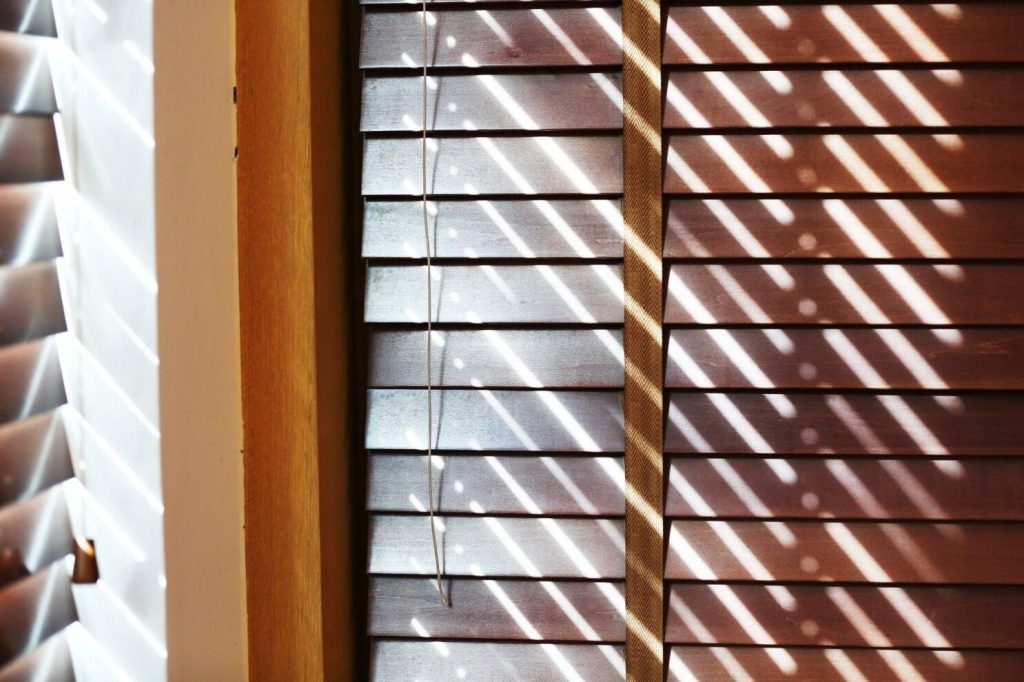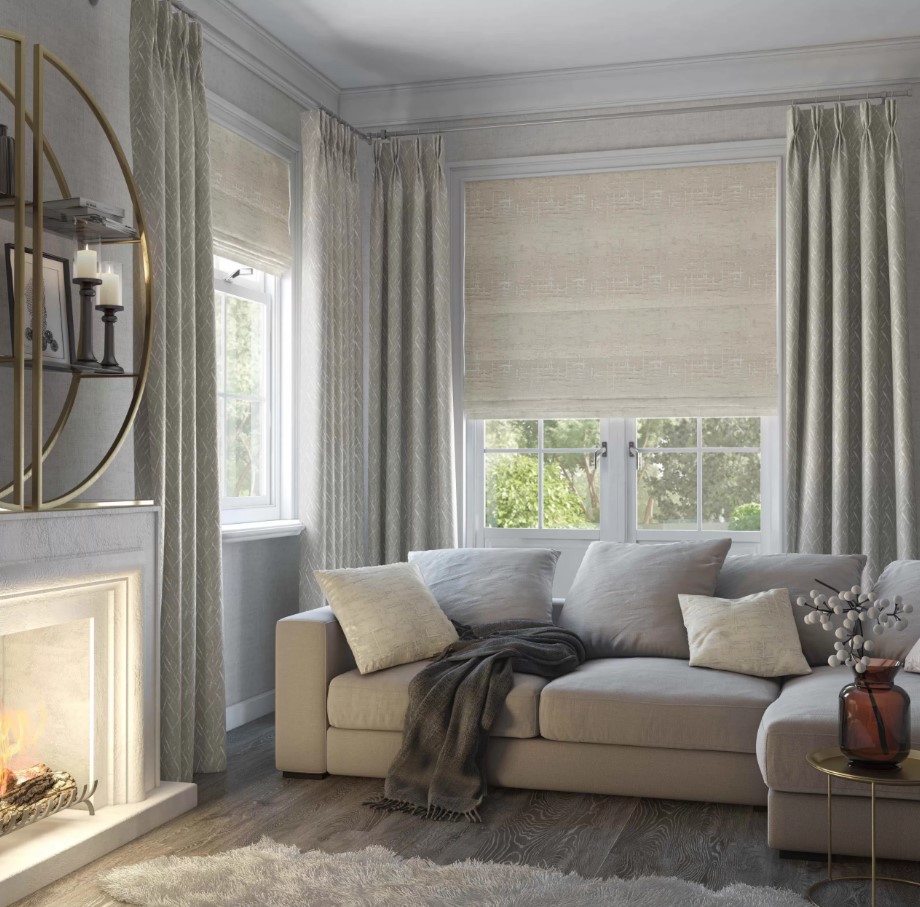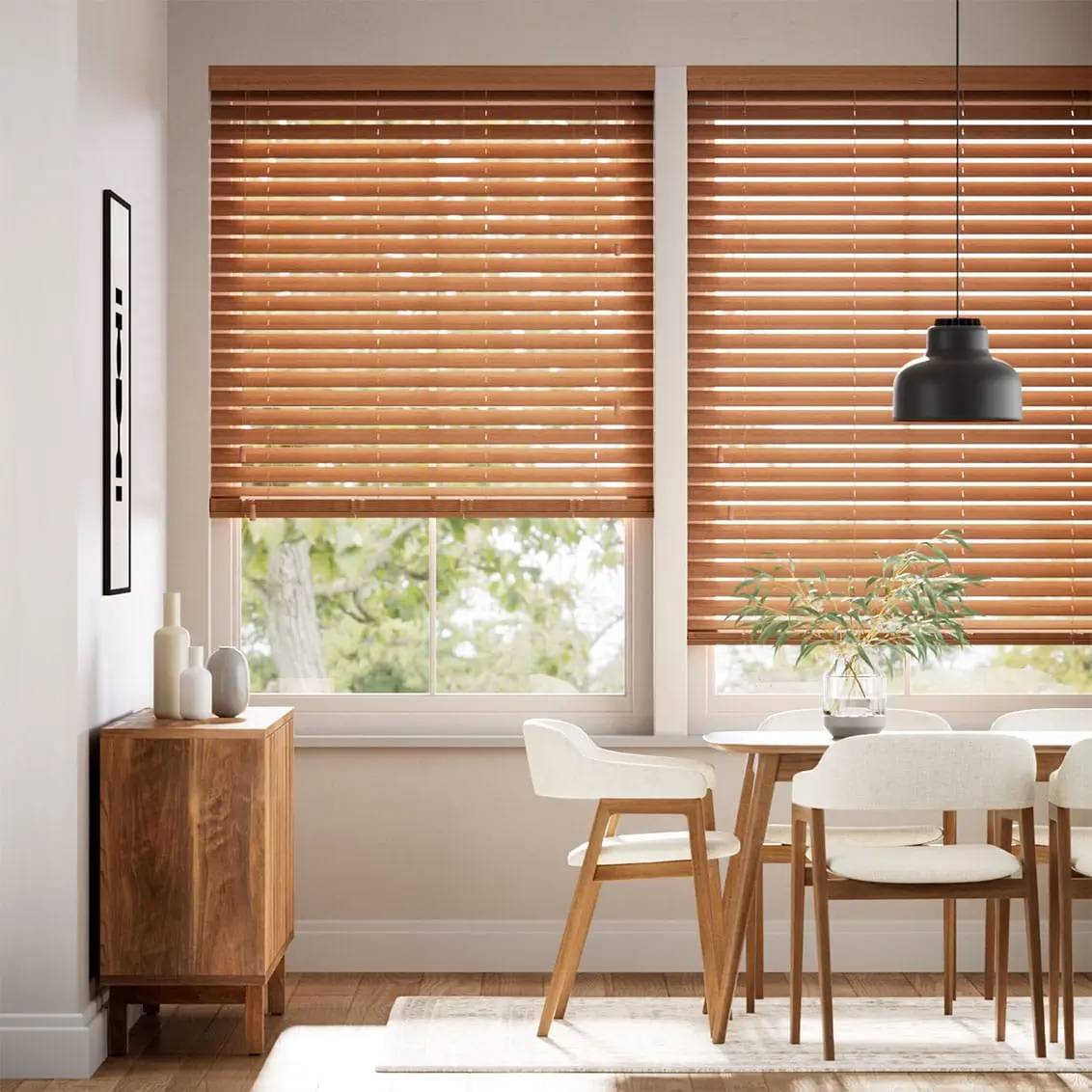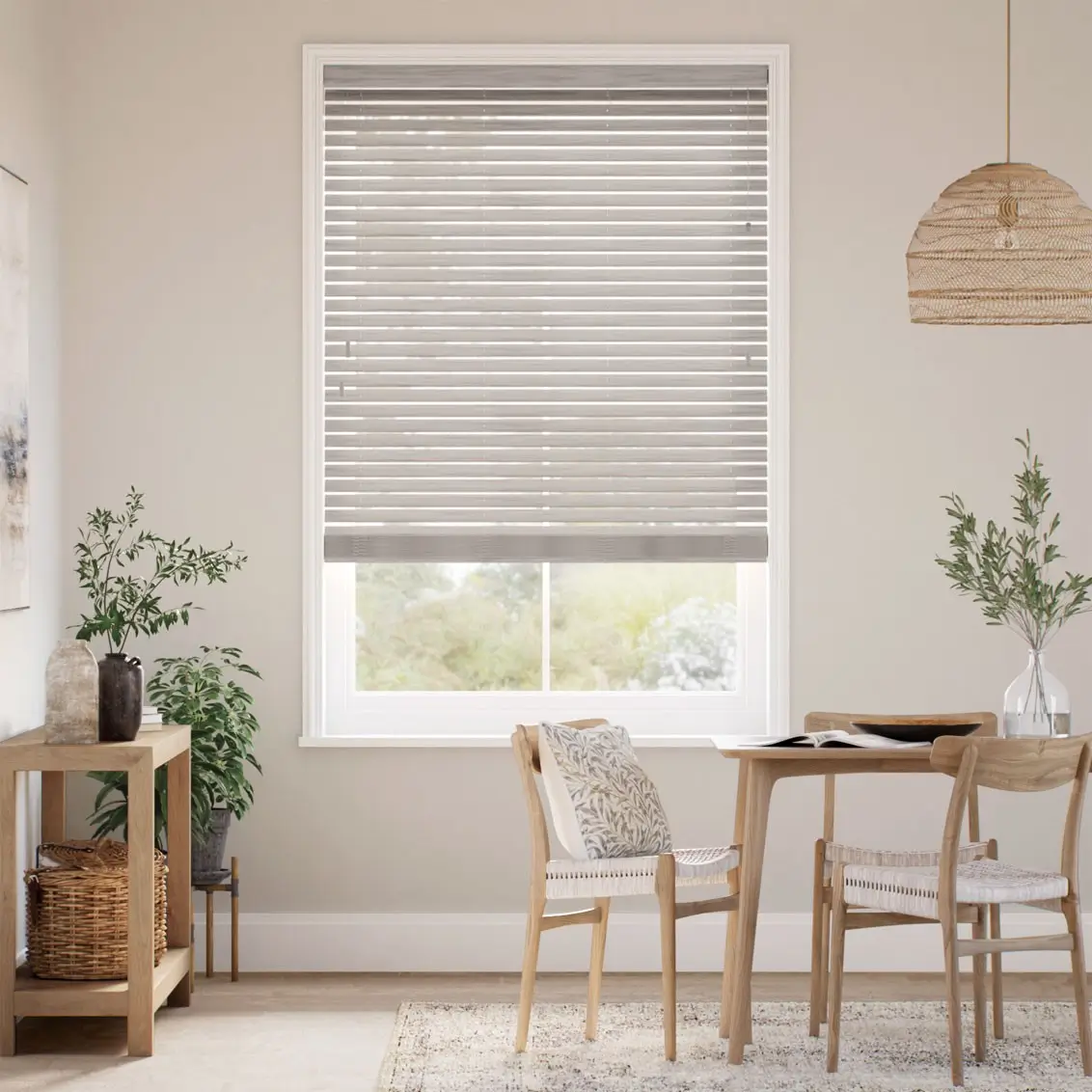Written by Nyla Thompson, founder of DecorifyIt and home improvement expert with 15+ years of hands-on experience
Oak trim brings timeless character to any room, offering rich warmth and a touch of traditional charm. But when it comes to window treatments, not every blind suits oak’s golden undertones. The right pairing enhances both beauty and functionality—creating harmony without overpowering the trim’s natural appeal. Whether you lean modern or classic, here’s how to confidently choose blinds that complement oak trim beautifully.
Oak Trim & Blinds: Why This Combo Deserves Attention
Oak trim is a design statement that stands the test of time. It brings natural character into a space—those golden undertones and visible grain patterns warm up rooms instantly. But pairing it with the wrong blinds can either clash visually or mute its charm. Think of blinds as the frame to your oak-trimmed windows. When chosen wisely, they help highlight the trim rather than overshadow it.
Many homeowners struggle with this choice because oak trim isn’t neutral—it leans warm and can sometimes look orange or yellow under artificial light. That’s why choosing blinds becomes about balance: you’re either complementing that warmth or cooling it down just enough to create contrast. The result? A room that feels intentional, well-designed, and welcoming.
Designers often say the goal isn’t just color matching—it’s visual harmony. And with oak, that starts by understanding what colors truly flatter it.
What Colors of Blinds Go Best with Oak Trim?
Let’s break it down by color family and what each brings to the table when paired with oak trim:
1. Neutral Tones – The Safe, Stylish Bet
Neutral colors like white, ivory, or light cream are go-to choices for good reason. They reflect natural light, keep the space looking fresh, and let the wood grain take center stage. In rooms with lots of sunlight, white blinds also help tone down any potential yellowness in the oak.
If your walls are a cooler neutral like dove gray or soft white, neutral blinds will act as a bridge between wall and trim, tying the whole look together without overcomplicating the palette.
Tip: Choose warmer off-whites (like antique white) if your oak trim has a deep honey or orange undertone. This prevents stark contrast that can look jarring.
2. Warm Tones – Cozy, Blended Aesthetic
Shades like sand, beige, or mocha melt seamlessly into oak trim. These colors mimic the earthy richness of the wood, making the trim feel like an extension of the room rather than a bold accent.
Warm-toned blinds are perfect for traditional or transitional interiors. They give the space a lived-in, comfortable look, especially in areas like dens, bedrooms, or libraries where a snug feel matters. If you’re updating a rustic-style room, pairing warm blinds with wooden floors can also elevate the overall aesthetic. Our post on how to make hardwood floors shine offers additional ways to complement oak tones beautifully.
In fact, in a recent Houzz trends report, warm earth tones were ranked among the top three most popular window treatment shades in homes with mid-toned wood trim.
3. Cool Tones – Bold, Balanced Contrast
Looking to modernize your oak trim? Go for blinds in cool grays, soft navy, or sage green. These shades cut through the warmth of oak, creating a sense of depth and designer contrast.
This approach works particularly well in modern farmhouse or contemporary settings. It’s about mixing old and new: the classic woodwork of oak with the updated palette of cooler tones.
Slate gray Venetian blinds, for example, can make an oak-trimmed office feel elevated and intentional, especially when paired with matte black fixtures or stainless steel hardware.
Real home example: A DecorifyIt client paired deep charcoal blinds with honey oak trim in their open-concept kitchen-diner. The result? An unexpectedly fresh combo that tied together their gray-toned backsplash and wooden island perfectly.
Style Compatibility: Choosing Blinds to Match Your Aesthetic
Beyond color, the type of blinds you pick should align with the vibe of the room. Here’s how to think through it based on your style:
Modern & Minimalist
Simplicity is key. Roller blinds, solar shades, or vertical panels in solid light hues create a clean backdrop. Look for fabrics with a subtle texture, like linen or woven polyester, which add softness without pattern overload.
If you have oak trim but want to pull the room into a more contemporary zone, contrast is your friend. Pair crisp white blinds with matte black curtain rods or add recessed blinds that disappear into the window frame.
Expert Tip: Light-filtering roller shades allow natural light to pass through while toning down harsh glares—ideal for oak-heavy living rooms with lots of sunlight.
Traditional & Classic
Here, texture and richness matter. Think Roman shades in thick cotton, linen blends, or even velvet. Wood blinds in a matching or slightly darker stain than your oak trim can enhance the classic appeal and create continuity across millwork.
Don’t shy away from layered treatments: Roman shades beneath drapes in a tone similar to your oak trim can create a lush, high-end look often seen in historic homes or formal sitting rooms.
Eclectic or Boho
If your style leans layered and personal, keep the blinds understated so your collected décor shines. Go with soft neutrals, pastels, or even textured woven shades. Rattan or bamboo blinds, for instance, blend beautifully with oak’s natural vibe while still offering a unique touch. To see how natural textures elevate a space, check out our inspiration guide on furniture makeover magic.
A light gray roller blind with a linen finish can act as a neutral base while still adding softness to a bold gallery wall or patterned rug setup.
Functionality and Feel: Blinds That Do More Than Look Good
While aesthetics set the tone, your blinds need to perform well in real-life conditions—blocking light when needed, offering privacy, and complementing the purpose of each room. Here’s how to factor in practicality without sacrificing style:
Light Management
The direction your windows face plays a big role in how much natural light floods in.
- South-facing rooms tend to get full sun throughout the day. In this case, you might opt for light-filtering blinds that reduce glare but still let light pass through—like solar roller shades or woven wood blinds with liners.
- North-facing spaces, on the other hand, can feel dim, so use light-colored blinds (white, cream, or pastel) that reflect what little light is available and help open up the room.
In smaller rooms or those with limited daylight, lighter blinds work double duty—visually expanding the space while keeping the oak trim from feeling too heavy or outdated.
Room Usage
Different spaces demand different blind characteristics:
- Bedrooms need peace and darkness. Blackout blinds or lined Roman shades in a deeper hue (like slate or espresso) can enhance sleep quality while visually balancing the warmth of oak trim.
- Living rooms call for airy, casual treatments. Try sheer roller shades, which soften the light while still letting the oak detail shine.
- Kitchens benefit from easy-to-clean materials like faux wood or metal blinds. Go for moisture-resistant materials that hold up to splashes and heat while echoing the tones of nearby oak cabinets or trim.
Privacy Considerations
For homes facing a busy street or neighboring windows, privacy is key.
- Wood or faux wood blinds offer excellent coverage and can be tilted to allow light in without sacrificing privacy.
- Layered options, such as a sheer blind paired with a thicker drape, give you the flexibility to adjust throughout the day.
Quick Tip: Consider top-down/bottom-up blinds for bathrooms or street-facing rooms. These allow you to block the lower half of the window while still letting light in from above—a functional win that doesn’t compromise your oak trim’s visibility.
If you’re also rethinking your window layout or design elements, see how others are making upgrades in our post on quick kitchen upgrades that also work well with oak cabinetry and trim.
Practical Tips from a Home Expert
Now that you’ve narrowed down colors and functionality, let’s talk practical advice. This is where many homeowners get stuck—so here’s how to make your decision with confidence:
1. Coordinate, Don’t Compete
While it’s tempting to pick trendy patterns or colors, always step back and ask: does this blind help or fight the trim? The safest bet is to match your blinds to either the trim or the wall color, keeping the overall look cohesive. If you’re going bold with contrast, make sure it complements the rest of your palette (like cool blinds tying into a cool-toned rug or art).
Real-life scenario: One DecorifyIt reader matched her pale beige blinds to the oak floor rather than the trim, unintentionally drawing the eye away from the beautiful crown molding. After switching to warm gray blinds that echoed the wall color, the space instantly felt more connected.
2. Always Test Samples in Your Home
Lighting affects color. A blind that looks neutral in a store can appear greenish or yellow once installed. Order swatches and tape them next to the trim. Observe them during different times of day—morning, noon, and evening—under both natural and artificial light.
Place samples near furniture and walls too. It’s the only way to be sure your selection complements the full space, not just the trim.
3. Consider Material as Much as Color
Blinds come in a range of materials, each with its pros and cons:
- Wood Blinds: Offer richness and depth, great for traditional or craftsman homes. Match them closely with your oak trim for a cohesive look.
- Faux Wood: Less expensive and moisture-resistant, perfect for kitchens, bathrooms, or humid climates. We explain more about moisture-resistant finishes in our article on using steam mops on hardwood floors.
- Fabric Shades: Add softness and warmth, and work beautifully in bedrooms or boho-style living rooms.
- Metal or Vinyl: Sleek and minimal—ideal for modern spaces, though they can feel cold if not balanced with warmer accents elsewhere.
Conclusion: Style, Function & Oak Can Coexist Beautifully
Pairing blinds with oak trim doesn’t have to be overwhelming—it just needs thoughtfulness. The oak provides built-in warmth and texture, and your blinds should either echo that natural beauty or provide contrast in a way that elevates the room. If you’re considering more changes to enhance your home’s interior, our guide to choosing the right furniture may help bring everything together—from windows to furnishings.
Here’s your takeaway:
- Neutrals let oak take the lead and brighten the room.
- Warm tones blend for a seamless, cozy look.
- Cool hues offer striking contrast and a modern update.
- Functionality matters—don’t overlook light control, privacy, and room-specific needs.
- Test samples and trust your instincts.
Your oak trim is already doing heavy lifting in terms of design. The right blinds don’t compete—they complete the look.
Frequently Asked Questions (FAQs)
What color blinds go best with oak trim?
Neutral tones like white, cream, or light beige are the most versatile. They highlight the warmth of oak without clashing. If you prefer contrast, cool shades like slate gray or soft green can create a modern look. Matching the blinds to your trim or choosing warm tones like taupe also works beautifully.
Should blinds match the oak trim or the wall color?
It depends on your design goal. If you want a seamless look, match the blinds to the oak trim. For more contrast or to modernize the space, coordinate them with your wall color instead. This creates visual balance and keeps the focus on the trim’s character.
What blinds are best for a modern room with oak trim?
Roller blinds, vertical panels, or minimalist Venetian blinds in white, gray, or pale stone colors work well. These styles keep the space open and contemporary while allowing the oak trim to add a touch of organic warmth.
Are wooden blinds a good choice with oak trim?
Yes, wooden blinds can work very well—especially if stained in a tone similar to or slightly darker than your oak trim. They create a unified, traditional look and add texture. Just be cautious in high-moisture rooms like bathrooms, where faux wood is a better option.
Do darker blinds make a room look smaller?
They can if the room lacks natural light. Dark blinds absorb light and can make a space feel enclosed. If your room is small or dim, it’s better to use lighter shades that reflect light and create a more open feel.
How do I know what color will look right in my home?
Always test samples in your actual space. Lighting affects how colors appear, so tape swatches near your oak trim and observe them at different times of day. What looks neutral in-store might look too yellow or gray at home.




